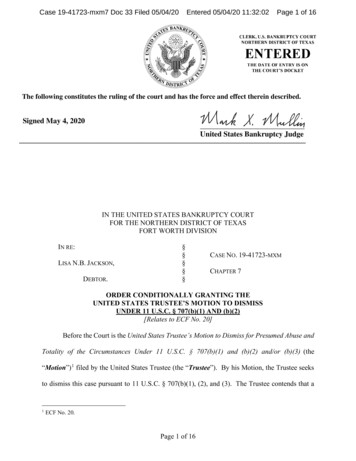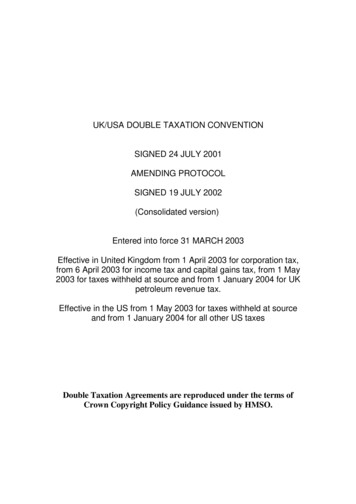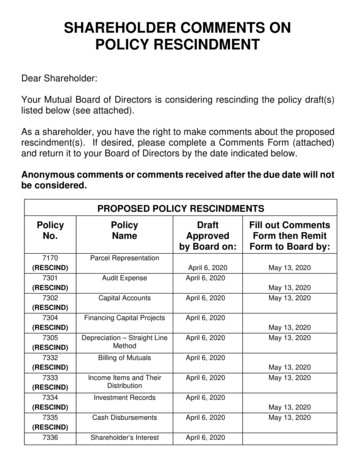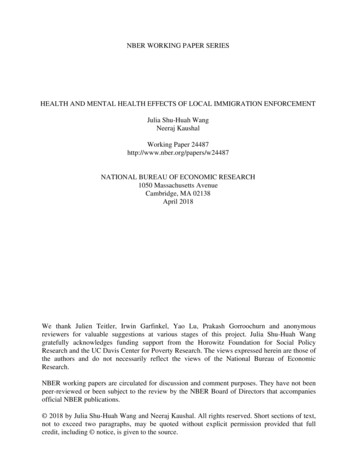
Transcription
Case 19-41723-mxm7 Doc 33 Filed 05/04/20Entered 05/04/20 11:32:02Page 1 of 16The following constitutes the ruling of the court and has the force and effect therein described.Signed May 4, 2020United States Bankruptcy JudgeIN THE UNITED STATES BANKRUPTCY COURTFOR THE NORTHERN DISTRICT OF TEXASFORT WORTH DIVISIONIN RE:LISA N.B. JACKSON,DEBTOR.§§§§§CASE NO. 19-41723-MXMCHAPTER 7ORDER CONDITIONALLY GRANTING THEUNITED STATES TRUSTEE’S MOTION TO DISMISSUNDER 11 U.S.C. § 707(b)(1) AND (b)(2)[Relates to ECF No. 20]Before the Court is the United States Trustee’s Motion to Dismiss for Presumed Abuse andTotality of the Circumstances Under 11 U.S.C. § 707(b)(1) and (b)(2) and/or (b)(3) (the“Motion”) 1 filed by the United States Trustee (the “Trustee”). By his Motion, the Trustee seeksto dismiss this case pursuant to 11 U.S.C. § 707(b)(1), (2), and (3). The Trustee contends that a1ECF No. 20.Page 1 of 16
Case 19-41723-mxm7 Doc 33 Filed 05/04/20Entered 05/04/20 11:32:02Page 2 of 16“presumption of abuse” arises in this case pursuant to § 707(b)(2) because the Debtor utilizedimproper spousal adjustments to income in her Form 122A-2 Means Test calculation.Alternatively, the Trustee argues that the totality of the circumstances of the Debtor’s financialcondition warrant a finding of abuse pursuant to § 707(b)(3). The Debtor maintains that thedeductions taken on the Form 122A-2 Means Test are accurate, appropriate, and substantiated;accordingly, no presumption of abuse or actual abuse arises under § 707(b). Further, even if thepresumption of abuse is established under § 707(b)(2)(A), the Debtor contends that she hassuccessfully rebutted the presumption of abuse by demonstrating special circumstances under §707(b)(2)(B). Finally, the Debtor argues that the Trustee cannot satisfy his burden to establish thatthe totality of circumstances of the Debtor’s financial situation establishes abuse under §707(b)(3)(B).The Court has reviewed and considered the Motion, the Response, 2 the testimony of LisaN.B. Jackson (the “Debtor”), the exhibits admitted into evidence, and the arguments of counsel.The following constitutes the Court’s Findings of Fact and Conclusions of Law 3 in support of thisruling as required by Federal Rule of Civil Procedure 52, made applicable in this contested matterby Federal Rules of Bankruptcy Procedure 9014 and 7052.I.JURISDICTION AND VENUEThe Court has subject matter jurisdiction over this contested matter pursuant to 28 U.S.C.§§ 1334(b) and 157(a) and the standing order of reference in this district. This contested matterinvolves a core proceeding over which the Court has both statutory and constitutional authority to2Response to United States Trustee’s Motion to Dismiss, ECF No. 24 (the “Response”).Any findings of fact that should be more appropriately be characterized as a conclusion of law should be regardedas such, and vice versa.3Page 2 of 16
Case 19-41723-mxm7 Doc 33 Filed 05/04/20Entered 05/04/20 11:32:02Page 3 of 16enter final orders and judgments pursuant to 28 U.S.C. § 157(b)(2)(A), (B) and (O). Venue forthis contested matter is proper pursuant to 28 U.S.C. § 1409(a).II.A.FINDINGS OF FACTProcedural HistoryOn April 30, 2019 (the “Petition Date”), the Debtor filed her (i) Voluntary Petition forIndividuals Filing for Bankruptcy (the “Petition”),4 (ii) Official Form 122A-1 Chapter 7 Statementof Your Current Monthly Income (the “Form 122A-1”), 5 and (iii) Official Form 122A-2 Chapter7 Means Test Calculation (the “Form 122A-2 Means Test”).6On May 30, 2019, the Debtor filed her Schedules 7 and Statement of Financial Affairs. 8On June 19, 2019, the first meeting of creditors pursuant to 11 U.S.C. § 341 was held andconcluded. Thereafter, on June 27, 2019, the Trustee timely filed a Statement of Presumed Abuse 9pursuant to § 707(b), and on July 29, 2019, the Trustee timely filed the Motion. 10 On August 19,2019, the Debtor filed her Response. 11The hearing date on the Motion was March 12, 2020 (the “Hearing Date”).4ECF No. 1; see also Trustee Ex. 1.5Petition at 18-20.6Id. at 21-31.7ECF No. 8; see also Trustee Ex. 5.8ECF No. 9; see also Trustee Ex. 6.9ECF No. 16; see also 11 U.S.C. § 704(b)(1)(A).10Motion; see also 11 U.S.C. § 704(b)(2).11ECF No. 24.Page 3 of 16
Case 19-41723-mxm7 Doc 33 Filed 05/04/20B.Entered 05/04/20 11:32:02Page 4 of 16The Debtor’s Family Background, Monthly Income and Expenses, and Liabilities andAssetsAs of the Hearing Date, the Debtor was married to her non-filing spouse (for convenience,“Husband”), and they were living in the same household and were not legally separated. 12 TheDebtor and her Husband have five dependents: the Debtor’s seventy-seven-year-old mother, threedaughters ages twelve, eleven, and eight, and one six-year-old son.The Debtor has been employed as a Senior Analyst at American Airlines for ten years. Herincome is stable, and she grosses 8,756 per month. Husband has been employed in sales forapproximately two years at Perigee, a company of which he owns thirty-three percent. Husband’sincome has also been stable, and he too grosses approximately 8,750 per month. Combined, asof the Petition Date, the total monthly income for the Debtor and Husband was 17,506. 13As of the Petition Date, the Debtor’s and Husband’s combined total monthly income was 17,506.6614 and the Debtor’s monthly disposable income was negative 409.31 . 15 Further,pursuant to the Debtor’s schedules, her monthly family expenses exceeded monthly income by 592.66 .16As of the Hearing Date, the Debtor asserted that her and her Husband’s combined totalmonthly income had increased slightly to 17,681.80, 17 and the Debtor’s monthly disposableTestimony of Debtor [11:19-20]. The Debtor testified, however, that their marriage was not stable, and that Husbandhad been consulting with a divorce attorney. See Testimony of Debtor [12:50-51].1213Petition at 18; see also Trustee Ex. 1 at 18; Trustee Ex. 5 at 28.14Petition at 19, line 11; Trustee Ex. 1 at 32, line 11.15Petition at 28, line 39c.16ECF No. 8 at 34, line 23c; Trustee Ex 5 at 34.17Debtor Ex. A (Official Form 122C-1) at 2, line 12.Page 4 of 16
Case 19-41723-mxm7 Doc 33 Filed 05/04/20Entered 05/04/20 11:32:02Page 5 of 16income improved slightly to a negative 245.91 . 18 In addition, the Debtor further asserted thather family monthly income less expenses had improved to 66.31. 19On the Petition Date, the Debtor’s liabilities consisted primarily of (i) secured debt ofapproximately 107,665 (secured by the Debtor’s homestead), 20 (ii) priority debt owed to theInternal Revenue Service of approximately 23,778; 21 and (iii) unsecured debt of approximately 239,986.22 The Debtor admits in her Petition that her liabilities are primarily consumer debts,both in quantity and amount.23Finally, the Debtor’s assets consist primarily of (i) her homestead valued at approximately 263,890, 24 (ii) three cars (1998 BMW, 2016 Honda Odyssey, and 2020 Honda Odyssey), (iii)household and related personal property valued at approximately 15,200, 25 (iv) cash value in awhole life insurance policy of 18,555, 26 and (v) the Debtor’s and Husband’s retirement 401k andIRA accounts of approximately 437,308.27III.CONCLUSIONS OF LAWThe Trustee seeks to dismiss this case pursuant to 11 U.S.C. § 707(b)(1), which provides,in relevant part, that the court "may dismiss a case filed by an individual debtor under this chapterwhose debts are primarily consumer debts . . . if it finds that the granting of relief would be an18Id. at 8, line 45.19Debtor Ex. B at 3.20ECF No. 8 at 15; Trustee Ex. 5 at 15.21ECF No. 8 at 16; Trustee Ex. 5 at 16.22ECF No 8 at 35; Trustee Ex. 5 at 35.23Petition; see also Trustee Ex. 1 at 6.24ECF No. 8 at 1; Trustee Ex. 5 at 1.25ECF No. 8 at 2-5; Trustee Ex. 5 at 2-5.26ECF No. 8 at 6; Trustee Ex. 5 at 6.27ECF No. 8 at 4; Trustee Ex. 5 at 4.Page 5 of 16
Case 19-41723-mxm7 Doc 33 Filed 05/04/20Entered 05/04/20 11:32:02Page 6 of 16abuse of the provisions of this chapter." 28 “Abuse” within the meaning of § 707(b)(1) can beestablished in two alternative ways. The first alternative is the presumption of abuse based on themeans test calculations detailed in § 707(b)(2). If the presumption of abuse under § 707(b)(2) doesnot arise or is rebutted, then the court may consider whether abuse is established under § 707(b)(3)by determining “whether the debtor filed the petition in bad faith” 29 or whether “the totality of thecircumstances . . . of the debtor’s financial situation demonstrates abuse.” 30In other words, § 707(b) provides a two-step process to detect and deter abusive filers: theobjective “means test” prescribed in § 707(b)(2), and the more subjective test of § 707(b)(3), whichrequires an analysis of the facts of the particular case. In this case, the Trustee argues that abuseis established under both §§ 707(b)(2)(A) and 707(b)(3)(B). 31 The Debtor responds that even ifthe presumption of abuse is established under § 707(b)(2)(A), the Debtor has rebutted thatpresumption through special circumstances under § 707(b)(2)(B). In addition, the Debtor arguesthat the Trustee cannot satisfy his burden to establish abuse under the totality of circumstances ofthe Debtor’s financial situation under § 707(b)(3)(B).A.§ 707(b)(2)(A) and the Presumption of AbuseUnder § 707(b)(2)(A)(i), a presumption of abuse depends on the results of the “means test,”which is a mathematical formula by which a debtor’s disposable income is calculated. Generally,the section provides that the court shall presume that abuse exists if the debtor’s current monthlyincome, reduced by the expenses or payments determined under § 707(b)(2), is greater that thethreshold amounts set forth in that section.2811 U.S.C. § 707(b)(1) (emphasis added).2911 U.S.C. § 707(b)(3)(A).3011 U.S.C. § 707(b)(3)(B).31See Motion. The Trustee does not argue or allege “bad faith” under § 707(b)(3)(A).Page 6 of 16
Case 19-41723-mxm7 Doc 33 Filed 05/04/20Entered 05/04/20 11:32:02Page 7 of 16Under this test, the court is first instructed to compare the debtor’s annualized currentmonthly income to the median family income of a similarly sized family in the debtor’s state ofresidence. If the debtor’s annualized current monthly income is equal to or below the annualmedian income, then the presumption of abuse does not arise. 32 If, however, the debtor’sannualized current monthly income exceeds the annual median income of a similarly sized familyin the debtor’s state of residence, then the debtor is directed to calculate the debtor’s monthlydisposable income under § 707(b)(2)(A) by deducting certain necessary expenses specified in thestatute. 33In this case, the Debtor’s Form 122A-1 reflects that the Debtor’s and Husband’s annualizedincome of 210,07934 exceeds the median family income of 110,96035 that applies in the Debtor’scase. Therefore, the Court is directed to the Debtor’s Form 122A-2 Means Test to determine if apresumption of abuse exists in this case.36 The Debtor contends that, based on the calculations inher Form 122A-2 Means Test, there is no presumption of abuse in this case. 37 The Trustee, on theother hand, disputes certain of the Debtor’s spousal adjustments made in her Form 122A-2, andcontends that the elimination of these improper spousal adjustments will result in a presumptionof abuse in this case.In her Form 122A-2 Means Test, the Debtor declares 3,009.50 in total spousaladjustments to her Husband’s income. 38 The Trustee disputes the legitimacy of at least 1,938.473211 U.S.C. § 707(b)(7).33Id.; see also 11 U.S.C. § 707(b)(2(A)(ii).34See Trustee Ex. 1 at 20, line 12b.35Id. at 20, line 13.36Id. at 20, line 14b.37Id. at 29, line 40.38Id. at 21, line 3.Page 7 of 16
Case 19-41723-mxm7 Doc 33 Filed 05/04/20Entered 05/04/20 11:32:02of the spousal adjustments taken by the Debtor.Page 8 of 16The Trustee asserts that after making acorresponding correction to eliminate the improper spousal adjustments, the revised Debtor’sForm 122A-2 Means Test will establish a presumption of abuse under § 707(b)(2).39 The Courtwill address each of the disputed spousal adjustments taken by the Debtor in her Form 122A-2Means Test.1.Spousal Adjustment for Husband’s alleged IRS Payments 40On her Form 122A-2 Means Test, the Debtor claims a spousal adjustment of 53.70 forher Husband’s IRS obligations. 41 The Trustee contends that this spousal adjustment is improperbecause the proposed adjustment actually constitutes a joint unsecured tax expense of both theDebtor and her Husband, as opposed to her Husband’s sole tax obligation. In support of hisobjection, the Trustee points to the Debtor’s Schedule E42 and the Debtor’s tax returns 43 asevidence that the tax obligation associated with the proposed spousal adjustment constitutes a jointunsecured obligation of both the Debtor and her Husband.The Debtor failed to rebut the Trustee’s credible evidence or otherwise establish thevalidity of the claimed spousal adjustment on the Form 122A-2 Means Test. Therefore, the Courtdisallows the 53.70 as a spousal adjustment on the Debtor’s Form 122A-2 Means Test.39Motion ¶ 34.40Id. ¶¶ 29, 35.41See Trustee Ex. 1 at 21, line 3.42See Trustee Ex. 5 at 16.43See Trustee Exs. 16, 17, and 36.Page 8 of 16
Case 19-41723-mxm7 Doc 33 Filed 05/04/202.Entered 05/04/20 11:32:02Page 9 of 16Spousal Adjustment for Husband’s Separate Credit Card Expenses 44On her Form 122A-2 Means Test, the Debtor claims a spousal adjustment of 1,249.00 forher Husband’s separate credit card expenses. 45 The Trustee contends that the Debtor’s proposedspousal adjustment is improper because the credit card statements reflect that the Husband’s creditcard was used for household expenses including, but not limited to, utility bills, children’sgymnastic and soccer fees, family trips, and other family household expenditures for the benefitof the entire family and not just for the benefit of Husband. Therefore, the Trustee contends thatthe Debtor’s asserted spousal adjustment for credit card payments do not qualify as a properspousal adjustment.The clear evidence, including the Debtor’s testimony and a review of the Husband’s creditcard statements, reflects that many of the charges to the Husband’s credit card were irrefutably forthe benefit of the household rather than for the Husband’s sole personal or business expenses.Further, the Debtor failed to provide credible evidence to support what charges or percentage, ifany, of the credit card charges were attributable solely to the Husband or his business expenses.Therefore, based on the Trustee’s credible evidence, the Court finds that the Trustee has satisfiedhis burden of proof to demonstrate that the Debtor’s spousal adjustment of 1,249.00 taken on herForm 122A-2 Means Test was not proper and should be disallowed.3.Spousal Adjustment for Housekeeping Expense 46On her Form 122A-2 Means Test, the Debtor claims a spousal adjustment of 390.00 forhousekeeping expenses. 47 The Trustee contends that this expense benefits the entire household as44Motion ¶¶ 29, 37.45See Trustee Ex. 1 at 21, line 3.46Motion ¶¶ 29, 36.47See Trustee Ex. 1 at 31, line 3.Page 9 of 16
Case 19-41723-mxm7 Doc 33 Filed 05/04/20Entered 05/04/20 11:32:02Page 10 of 16opposed to an expense that benefits only the Husband. Indeed, at the hearing, the Debtor admittedin her testimony that this 390.00 expense was for a housekeeper that benefited the entirehousehold and not just the Husband. Therefore, based on the Trustee’s uncontroverted andcredible evidence, the Court finds that the Trustee has satisfied his burden of proof to demonstratethat the Debtor’s spousal adjustment of 390.00 taken on her Form 122A-2 Means Test was notproper and should be disallowed.4.Spousal Adjustment for Student Loans48On her Form 122A-2 Means Test, the Debtor claims a spousal adjustment of 548.00 forthe Husband’s student-loan payments. 49 The Trustee contends that this spousal adjustment isoverstated because the supporting documentation and evidence reveals that the maximum amountof the adjustment for the Husband’s student loan payments should be 302.23. 50 At the hearing,the Debtor testified that the monthly student-loan payments for both her and her Husband isapproximately 600.0051 and she specifically admitted in her Exhibit B that the Husband’smonthly student-loan payments are 302.23.52 Therefore, based on the Trustee’s uncontrovertedand credible evidence, the Court finds that the Trustee has satisfied his burden of proof todemonstrate that the Debtor’s spousal adjustment of 548.00 taken on her Form 122A-2 MeansTest was overstated and should be reduced by 245.77, to 302.23.48Motion ¶ 30.49See Trustee Ex. 1 at 31, line 3.50See Motion ¶ 30.51See Testimony of Debtor [11:27].52See Debtor Ex. B, line 17c.Page 10 of 16
Case 19-41723-mxm7 Doc 33 Filed 05/04/205.Entered 05/04/20 11:32:02Page 11 of 16Summary of Spousal AdjustmentsBased on the above adjustments to the Debtor’s Form 122A-2 Means Test, the Debtor’smonthly disposable income in the original negative amount of 409.31 53 is revised to reflectpositive monthly disposable income of 1,529.16, which substantially exceeds 13,65054 whenmultiplied by 60 ( 91,749.60). Therefore, a “presumption of abuse” arises in this case pursuant to§ 707(b)(2).B.§ 707(b)(2)(B) – Special CircumstancesBecause the Trustee has established that a presumption of abuse exists under § 707(b)(2),the Debtor may seek to rebut this presumption by demonstrating “special circumstances” under §707(b)(2)(B). As previously noted, § 707(b)(2)(A) provides standards by which expenditures maybe deducted to calculate a debtor’s disposable income to determine whether the presumption ofabuse arises. In the Chapter 13 context, the standards for expenditures in § 707(b)(2)(A) are usedto calculate a debtor’s disposable income available to fund a plan and to pay unsecured creditors. 55An expenditure is a permissible deduction in determining Chapter 13 disposable income to thesame extent it is permissible in determining whether a presumption of abuse arises in Chapter 7.Section 707(b)(2)(B) allows a debtor to rebut the presumption of abuse in Chapter 7 (or totake additional deductions when calculating disposable income in Chapter 13) by demonstratingthat the debtor has special circumstances that “justify additional expenses or adjustments of currentmonthly income for which there is no reasonable alternative.”56 To establish such “special53Id. at 28, line 39c.54See 11 U.S.C. § 707(b)(2)(A)(i)(II).55See 11 U.S.C. § 1325(b).56See 11 U.S.C. § 707(b)(2)(B)(i).Page 11 of 16
Case 19-41723-mxm7 Doc 33 Filed 05/04/20Entered 05/04/20 11:32:02Page 12 of 16circumstances,” the debtor is required to “itemize” and to provide “documentation” and a “detailedexplanation” to justify the need for and reasonableness of the additional expenses. 57Although courts generally agree that “special circumstances” should be decided on a caseby-case basis, courts are divided over what constitutes a special circumstance. 58 This Court haspreviously held that “[§] 707(b)(2)(B) leaves discretion with the court to account for differencesbetween individual debtors” and that “the determination whether a particular circumstance isspecial should be made on a case-by-case basis.” 59 Further, “[T]he focus must be on whether thedebtor is, of necessity, in a different situation than the typical debtor addressed by the IRSguidelines.” 60The Debtor testified and offered into evidence as Exhibit A, both Official Form 122C-1and Official Form 122C-2,61 as support for certain expenses that she contends constitute validspecial circumstance deductions under § 707(b)(2)(B). During the hearing, the Trustee raisedspecific objections to certain of the alleged special circumstance deductions included in theDebtor’s Exhibit A. The Court, therefore, will determine for each of the deductions if the Debtorhas established (i) that each expense is necessary and reasonable and (ii) that there is no reasonablealternative to the expense. The Court considers each of the disputed expense deductions in turn.57See 11 U.S.C. § 707(b)(2)(B)(ii).58In re Everhart, 607 B.R. 565, 576 (Bankr. N.D. Tex. 2019) (citing In re Davis, No. 10-47600, 2011 WL 5884015,*4 (Bankr. N.D. Tex. 2011)).59In re Everhart, 607 B.R. at 577.60In re Davis, 2011 WL 5884015, at *5.61Debtor Ex. A.Page 12 of 16
Case 19-41723-mxm7 Doc 33 Filed 05/04/201.Entered 05/04/20 11:32:02Page 13 of 16Housekeeper - 390.00 62The Debtor testified that she works full time and that, given size of their household, shehas no ability to maintain a clean home and clean clothes for her family without the assistance ofa housekeeper at 390 per month. 63 The Debtor further claims that the expense is necessary andreasonable and that she has no other reasonable alternative. Although the Court sympathizes withthe Debtor’s difficult marital situation, neither she nor her Husband has a disability that preventsthem from undertaking household chores. Further, other than claiming her children were tooyoung, there was no other evidence to establish that the children were not able to assist withhousekeeping chores. The Court finds and concludes that based upon the totality of the Debtor’scircumstances, the Debtor’s situation does not differ in any material way from a typical debtoraddressed by the IRS guidelines. Therefore, the housekeeper expense of 390.00 per month doesnot rise to the level of a special circumstance under § 707(b)(2)(B) and may not be deducted.2.Lawn Care - 138.7464Like the housekeeper expense, the Debtor testified that because she works full time, shehas no ability to properly maintain the lawn without the assistance of a lawn-care service at 138.74 per month.65 For the same reasons the Court denied the housekeeper expense, the Courtalso denies the Lawn Care expense of 138.74 per month as a special circumstance. 66 Therefore,the Lawn Care expense of 138.74 per month does not rise to the level of a special circumstanceunder § 707(b)(2)(B) and may not be deducted.62Id. (Official Form 122C-2 at 7, line 43).63Testimony of Debtor [11:26].64Debtor Ex. A (Official Form 122C-2 at 7, line 43).65Testimony of Debtor [12:12].66See In re Everhart, 607 B.R. at 579.Page 13 of 16
Case 19-41723-mxm7 Doc 33 Filed 05/04/203.Entered 05/04/20 11:32:02Page 14 of 16Pool Maintenance - 117.9967According to the Debtor, the 117.99 pool-maintenance expense, like the housekeeper andlawn-care expense, relates to a special circumstance because she has no time or expertise to cleanthe pool herself. The Debtor testified that if the pool is not properly maintained, HOA covenantsmay be violated, the value of the property would decline, and the pool could become a safety andsanitation hazard.Pool maintenance is not provided for in the IRS guidelines and arguably constitutes aluxury expense that relatively few debtors incur. But if the pool is not properly maintained, itcould become a safety and sanitation hazard. Although the Debtor and the Trustee each makecompelling arguments in support of their positions, given the Court’s conclusions in regard to theDebtor’s housekeeping and lawn-care special-circumstance deductions, the Court need notdetermine the reasonableness and necessity of the pool expenses at this time. If the Debtor’s caseis ultimately converted to Chapter 13, whether the pool-maintenance expense rises to the level ofa special circumstance under § 707(b)(2)(B) is an issue that may be first considered and addressedby the Chapter 13 Trustee and creditors. If the pool-maintenance issue remains a disputed expensein the Chapter 13 case, then the Court can determine if the pool maintenance expense and anyother disputed expense items rise to the level of special circumstances.4.Summary of Alleged Special-Circumstance ExpensesAssuming the Housekeeping and Lawn Care expenses were the only items removed asspecial circumstances from the Debtor’s proposed Form 122C-2, 68 the resulting Debtor’s monthlydisposable income under § 1325(b)(2) would be 282.83, which exceeds 13,65069 when67Debtor Ex. A (Official Form 122C-2 at 7, line 43).68Debtor Ex. A.69See 11 U.S.C. § 707(b)(2)(A)(i)(II).Page 14 of 16
Case 19-41723-mxm7 Doc 33 Filed 05/04/20Entered 05/04/20 11:32:02Page 15 of 16multiplied by 60 ( 16,969.80). 70 Therefore, the Debtor has failed to rebut the presumption ofabuse under § 707(b)(2)(B). The Court further concludes that even if dismissal is not mandatoryunder § 707(b)(1),71 the dismissal of this case is appropriate unless, with the Debtor’s consent, thiscase is converted to Chapter 13.C.§ 707(b)(3)(B) – Totality of Circumstances of the Debtor’s Financial SituationBecause the Court has determined that granting relief in this case would be an abuse of theprovisions of Chapter 7 under §§ 707(b)(1) and (b)(2), it is not necessary for the Court to determineif this case should be dismissed pursuant to § 707(b)(3)(B).Based on these Findings of Fact and Conclusions of Law, the Court has determined thatthe Court will conditionally grant the Motion as follows; it is, thereforeORDERED, ADJUDGED, and DECREED that the Motion is conditionally granted asset forth below; and it is furtherORDERED that the Debtor may convert this case to Chapter 13 or to Chapter 11 withinfourteen days from the entry of this Order; and it is furtherORDERED that if the Debtor converts this case to Chapter 13 or to Chapter 11 withinfourteen days from the entry of this Order, then the Motion will be deemed DENIED withoutfurther order of the Court; and it is furtherORDERED that if the Debtor fails to convert this case to Chapter 13 or to Chapter 11within fourteen days from the entry of this Order, then the Motion shall be deemed GRANTED70See 11 U.S.C. § 707(b)(2)(B)(iv).11 U.S.C. § 707(b)(1) provides that the court may dismiss the case if the court finds that granting of relief would bean abuse of the provisions of this chapter. Courts disagree on whether dismissal is mandatory or permissive if thereis a presumption of abuse and the debtor fails to rebut the presumption of abuse. See In re Maura, 491 B.R. 493, 51618 (Bankr. E.D. Mich. 2013) (analyzing cases on whether dismissal is permissive or mandatory under § 707(b)(1)).This Court does not need to decide this issue because, under either line of cases, the Court concludes that the Debtor’scase should be dismissed, unless the Debtor voluntarily converts her case to Chapter 13 or Chapter 11.71Page 15 of 16
Case 19-41723-mxm7 Doc 33 Filed 05/04/20Entered 05/04/20 11:32:02and this case shall be DISMISSED without further order.### END OF ORDER ###Page 16 of 16Page 16 of 16
Voluntary Petition for Individuals Filing for Bankruptcy (the " Petition 4 (ii) Official Form 122A -1 Chapter 7 Statement of Your Current Monthly Income (the " Form 122A-1 5 and (iii) Official Form 122A-2 Chapter 7 Means Test Calculation(the " Form 122A-2 Means Test 6 On May 30, 2019, the Debtor filed her Schedules 7











